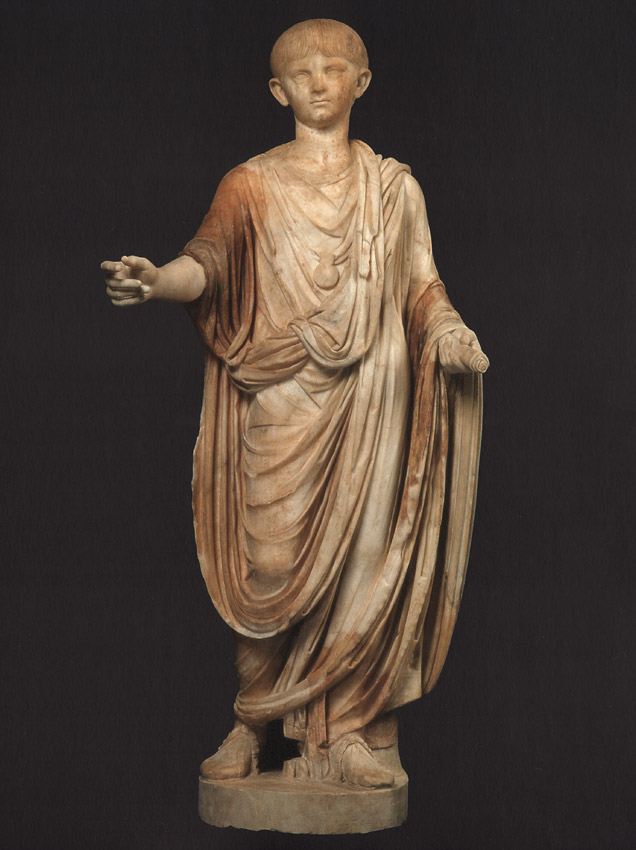
Height 138 cm. Inv. No. MR 337 (Ma 1210; N 1580).Paris, Louvre Museum
Statue of infant Nero in toga, with bulla, holding a scroll.
Height 138 cm.
Paris, Louvre Museum.
23. Portrait of Nero as a child
Ca. 50 A. D.
Provenance unknown
Fine-grained marble
H. 138 cm.
Purchased in 1807, formerly in the Borghese collection (MA 1210 — INV. MR 337; N 1580).
Restorer: D. Ibled, 2005.
When Claudius came to the throne, he was the last of the Julio-Claudians of his generation to take control of the empire. Only his legal heirs could legitimately succeed him. Claudius and Messalina’s one child, Britannicus, was seven years old when his mother was murdered in 48 A. D. as part of a scheme plotted by Agrippina the Younger. Agrippina, the granddaughter of Julia and Agrippa and great granddaughter of Augustus, planned to make Nero, her son from her first marriage, Claudius’s successor. She married Claudius in 48 A. D. and managed to convince him to adopt Nero two years later. Following the death of Claudius in 54 A. D., Nero became the emperor Tiberius Claudius Nero. Just a year later, Agrippina had Britannicus poisoned. Nero was then eighteen years old.
Claudius’s adoption of Nero occurred one year before Nero reached his legal majority at the age of fourteen and donned the toga virilis (adult man’s toga). The adoption made Nero his presumptive heir, and Nero’s image had to be promptly disseminated throughout the empire. The Louvre and the Museo Archeologico Nazionale di Parma have almost identical portraits of a young boy wearing a toga praetexta (a purple-bordered toga) and bulla (ornament worn around a child’s neck). The statue in Parma comes from the basilica in Velleia, where it was found with other Julio-Claudian portraits, including a depiction of Claudius.
Comparisons with coins bearing the image of Britannicus exclude the possibility that this is a portrait of Claudius’s natural-born son. The hairstyle is very similar to what is seen in the last Claudian portrait images, known as the Turin type, which feature hair combed very straight over the forehead and parted in a little “fork” over the nose or over the inside corner of the right eye. This hairstyle was worn by Claudius in the Sebasteion (a temple dedicated to the cult of the emperors) in Aphrodisias. The similarity of hairstyles emphasized the close affiliation of Claudius and Nero, though they had no actual blood tie.
Although here Nero’s mouth is already rather small and fleshy and his eyes appear sunken under low-arched brows, his face still has childlike appeal. However, the trend toward greater realism in imperial portraiture inaugurated under Claudius continued during Nero’s fourteen-year reign; thus the facial model in the four portrait types changed considerably as the young man matured physically: the hairstyle gained more volume, becoming more elaborate and even extravagant—
These changes represent more than just a quest for accurate depictions. The late portraits of Nero are striking because they demonstrate an approach to art that is aimed at producing a specific effect. These portraits reflect Nero’s aesthetic preoccupations and his determination to provocatively confront the veristic pattern of the time of the Republic, as well as the Augustan imperial ideology, which was based on balance, moderation, and a respect for traditional forms. In 69 A. D., Nero would pay for this attitude with his life.